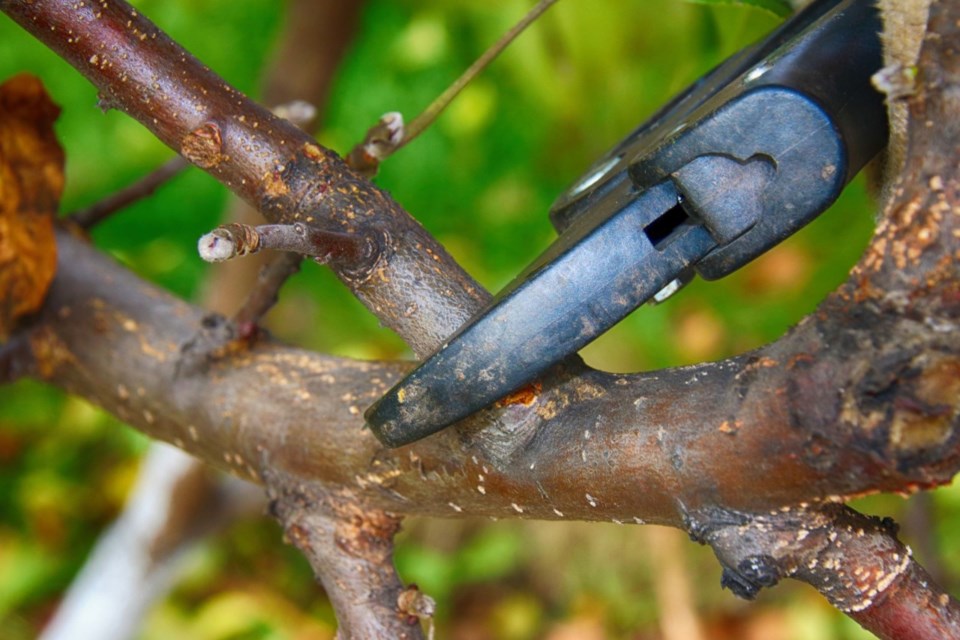The following column was submitted to the Tri-City News from Brian Minter — master gardener, best-selling author, Order of Canada recipient and co-owner of Minter Country Garden Store.
Like a good spring house cleaning, a thorough pruning can make your garden look clean and fresh at this time of year.
It can also improve the health of your trees, the quality of fruits and the abundance of flowering.
The problem for many folks, however, is knowing what to prune and how far back to prune it.
Well, the art of pruning is 90 per cent common sense and observation and 10 per cent experience and knowledge, acquired by simply getting out and doing it.
There is lots of information online about this subject, and if you need a good book as a guide, I suggest The Pruning Specialist by David Squire, New Holland Publishers.
The first thing you need to know is the type of pruning equipment to use.
Hand shears are the most useful garden tool you can have. It really does not matter whether you purchase the scissor type (sometimes called 'bypass' shears) or the anvil type.
My advice is to get a good quality pair for which you can purchase replacement blades. A lot of very inexpensive models are out there, but I find they often don’t stand up. Quality, medium to higher-priced shears will pay for themselves many times over. Remember too: shears are only meant for smaller branches, usually 3/8 inch (6 mm) or less in thickness. Unless it is very soft wood, once you get into thicker branches you really should be using two-handed loppers.
Loppers, like shears, are available in the bypass or anvil styles, and in all price ranges. My comments on quality apply here, too. Make sure the loppers you purchase have replaceable blades made of quality steel or teflon that can be sharpened. Today, you can get extendable handles to reach up farther into trees, helping you to avoid ladders. Loppers can be used for branches up to 1.5 inches (3.5 cm) in caliper.
For large branches, you need a good pruning saw. You can purchase either straight or curved blades, depending on personal preference. Some types fold in for convenience, while others come with handy sheaths that fit on your belt. The key to a quality pruning saw is good steel and well-designed teeth with serrations in opposite directions. This is especially important for cutting green, wet wood.
If you have massive evergreen plantings, you may choose to purchase a good electric or battery-operated trimmer. Electric ones are only effective on standard cords up to 100 feet long; beyond that you should be using a battery-operated one. With only a few evergreens, you will find two-handled grass clippers the best bet. If you stay in the softer growth from the previous season, these will do the job nicely.
If you are the proud owner of tall trees with even taller branches that elude you with a ladder, then you will find pole pruners the answer. After fighting branches with 10- and 12-foot pruners, I have found the adjustable types far easier to use. They also come with a saw blade for getting at branches too awkward or too large to cut.
I notice that folks who have a great many older, larger trees are using chain saws for pruning. For larger branches, a chain saw is a good deal easier and faster, but novices should get the feel of using these saws by first practising on fallen branches on the ground. On ladders, make sure of your stability, and wear goggles to protect your eyes.
For pruning really large trees, the safest route is to hire a tree expert who has the proper equipment to do the job. We have many good tree service companies in our area.
Keep all your shears clean by dipping them in a solution of one-part bleach to ten-parts water.
It is also very important to make your cuts with the blade cutting upward to prevent larger branches from tearing the bark as they fall. Always make a cut on the underside first, then move the blade over 1/4 inch (4 mm.) on top to get a clean cut every time. The only other important thing to remember when cutting branches is to cut them on a shallow angle just above a bud. This will prevent water from seeping in, will help eliminate diebacks on the branch and will direct new growth in the direction of the bud.





